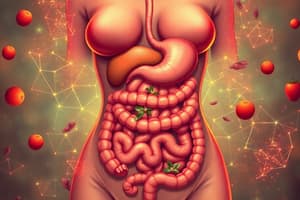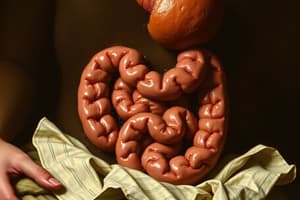Podcast
Questions and Answers
Which of the following is NOT a key component of the gastric phase of digestion?
Which of the following is NOT a key component of the gastric phase of digestion?
- Pancreatic lipase (correct)
- Salivary amylase
- Pepsin
- Gastric acid
What is the significance of understanding the consequences of eating patterns on both healthy individuals and those with digestive diseases?
What is the significance of understanding the consequences of eating patterns on both healthy individuals and those with digestive diseases?
- It allows for dietary interventions that optimize digestion in both groups.
- It highlights the need for specialized diets tailored to individual needs.
- It emphasizes the importance of education and counseling for patients with GI disorders.
- All of the above (correct)
What is the primary role of Registered Dietitians (RDs) in the management of digestive disorders?
What is the primary role of Registered Dietitians (RDs) in the management of digestive disorders?
- Providing nutritional counseling and dietary recommendations. (correct)
- Performing invasive procedures to assess digestive function.
- Diagnosing and treating specific digestive diseases.
- Prescribing medications and supplements.
Which of the following is considered a sign of severe malnutrition based on unintentional weight loss?
Which of the following is considered a sign of severe malnutrition based on unintentional weight loss?
What is the MAIN reason why dietary assessment is crucial in the management of digestive disorders?
What is the MAIN reason why dietary assessment is crucial in the management of digestive disorders?
What is the role of cholecystokinin in the digestive process?
What is the role of cholecystokinin in the digestive process?
Which of the following factors can contribute to a reduction in the lower esophageal sphincter (LES) pressure, leading to GERD?
Which of the following factors can contribute to a reduction in the lower esophageal sphincter (LES) pressure, leading to GERD?
What is the primary function of the lower esophageal sphincter (LES)?
What is the primary function of the lower esophageal sphincter (LES)?
Which of the following is NOT a common symptom of GERD?
Which of the following is NOT a common symptom of GERD?
Which of the following is a correct statement about the role of the pancreas in digestion?
Which of the following is a correct statement about the role of the pancreas in digestion?
What is the main difference between organic and functional digestive diseases?
What is the main difference between organic and functional digestive diseases?
Which of the following is an example of a functional digestive disease?
Which of the following is an example of a functional digestive disease?
Maldigestion can occur due to:
Maldigestion can occur due to:
Flashcards
Psychosomatic effects on GI
Psychosomatic effects on GI
The idea that mental state can influence gut health.
MNT
MNT
Medical Nutrition Therapy focuses on diet to manage GI disorders.
GI assessment indicators
GI assessment indicators
Signs like weight loss and nausea indicate GI issues.
Digestion phases
Digestion phases
Signup and view all the flashcards
Importance of RDs in GI
Importance of RDs in GI
Signup and view all the flashcards
Pancreatic lipase
Pancreatic lipase
Signup and view all the flashcards
Absorption
Absorption
Signup and view all the flashcards
Malabsorption
Malabsorption
Signup and view all the flashcards
Esophageal defense mechanisms
Esophageal defense mechanisms
Signup and view all the flashcards
GERD (Gastroesophageal Reflux Disease)
GERD (Gastroesophageal Reflux Disease)
Signup and view all the flashcards
Cholecystokinin
Cholecystokinin
Signup and view all the flashcards
Dysfunction of digestive phases
Dysfunction of digestive phases
Signup and view all the flashcards
Esophageal diseases
Esophageal diseases
Signup and view all the flashcards
Study Notes
Digestive System Diseases
- Diseases of the digestive system encompass various conditions affecting the oral cavity, esophagus, stomach, and other parts.
- Upper GI disorders involve the oral cavity, esophagus, and stomach.
- Thought and emotional factors can influence digestive system health and function.
- Malnutrition and nutrient deficiencies are secondary diseases that can result from GI disorders.
- Nutritional support is crucial in managing and preventing complications in digestive system disorders.
Assessment of GI
- Unintentional weight loss is a significant indicator of GI issues.
- Severe malnutrition is defined by percentages of weight loss over time.
- % ideal body weight (Ibw), body mass index (BMI) are used in assessing patients with GI problems.
- Symptoms like nausea (N/V), diarrhea, and dysphagia can signal GI issues.
- Allergies to food and/or medications may affect GI health.
- Lab tests like blood tests (CBC, ferritin, B12, folate) are used to assess the patient's nutritional status.
Digestion
- Digestion involves a mechanical breakdown (physical) and chemical breakdown of food using enzymes.
- Enzymes like salivary amylase, lipase, and pepsin are crucial for digestion.
- Pancreatic enzymes (lipase, protease, amylase) and bile salts also play important roles.
- The small intestine is where most of the absorption of nutrients occurs.
- Various factors can affect digestion and absorption (e.g., medications, diseases, and malnutrition).
Types of Digestion
- Pancreatic phase involves pancreatic enzymes released into the small intestine.
- Intestinal phase involves enzymes released from the small intestine, breaking down remaining nutrients.
- Maldigestion involves issues with any step of digestion, including problems with normal stomach emptying.
Absorption
- Absorption involves taking nutrients and transporting them into the bloodstream.
- Mostly occurs in the duodenum, with absorption of monosaccharides, amino acids, and fatty acids.
- Fat-soluble vitamins (e.g., vitamins A, D, E, K) require bile for absorption.
- Water-soluble vitamins (e.g., B vitamins and C) are absorbed into the intestinal mucosa.
- Malabsorption can arise from various problems (e.g., issues with digestive enzymes, infections).
Functional and Organic Diseases
- Functional diseases don't have structural damage (e.g., ulcerative colitis).
- Organic diseases involve actual structural damage to tissues (tissues).
- Stress and emotional factors can impact digestive function.
Esophageal Diseases
- The esophagus is a muscular tube connecting the pharynx to the stomach.
- Problems with esophageal sphincters (e.g., lower esophageal sphincter (LES)), can cause GERD.
- GERD is gastroesophageal reflux disease.
- Esophageal disorders can be obstructive, inflammatory, or nervous in nature.
GERD (Gastroesophageal Reflux Disease)
- GERD involves reflux of stomach contents into the esophagus.
- Symptoms include heartburn, substernal pain, belching, and esophageal problems
- GERD can impact adults between 20% to 40%.
- Diagnosis is often based on an upper endoscopy.
GERD Pathophysiology
- GERD involves a complex interplay of reduced lower esophageal sphincter pressure, mucosal irritants, decreased gastric motility, and increased intra-abdominal pressure.
- Pregnancy, oral contraceptives, and other factors can contribute to GERD problems
- Specific treatments vary.
Studying That Suits You
Use AI to generate personalized quizzes and flashcards to suit your learning preferences.




